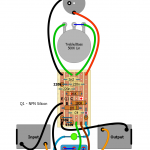
Here’s fun little project.
Easily can be squeezed into tinny A type enclosure.
Similar circuit topology could be found in JEN and Elka Treble-Bass Boosters
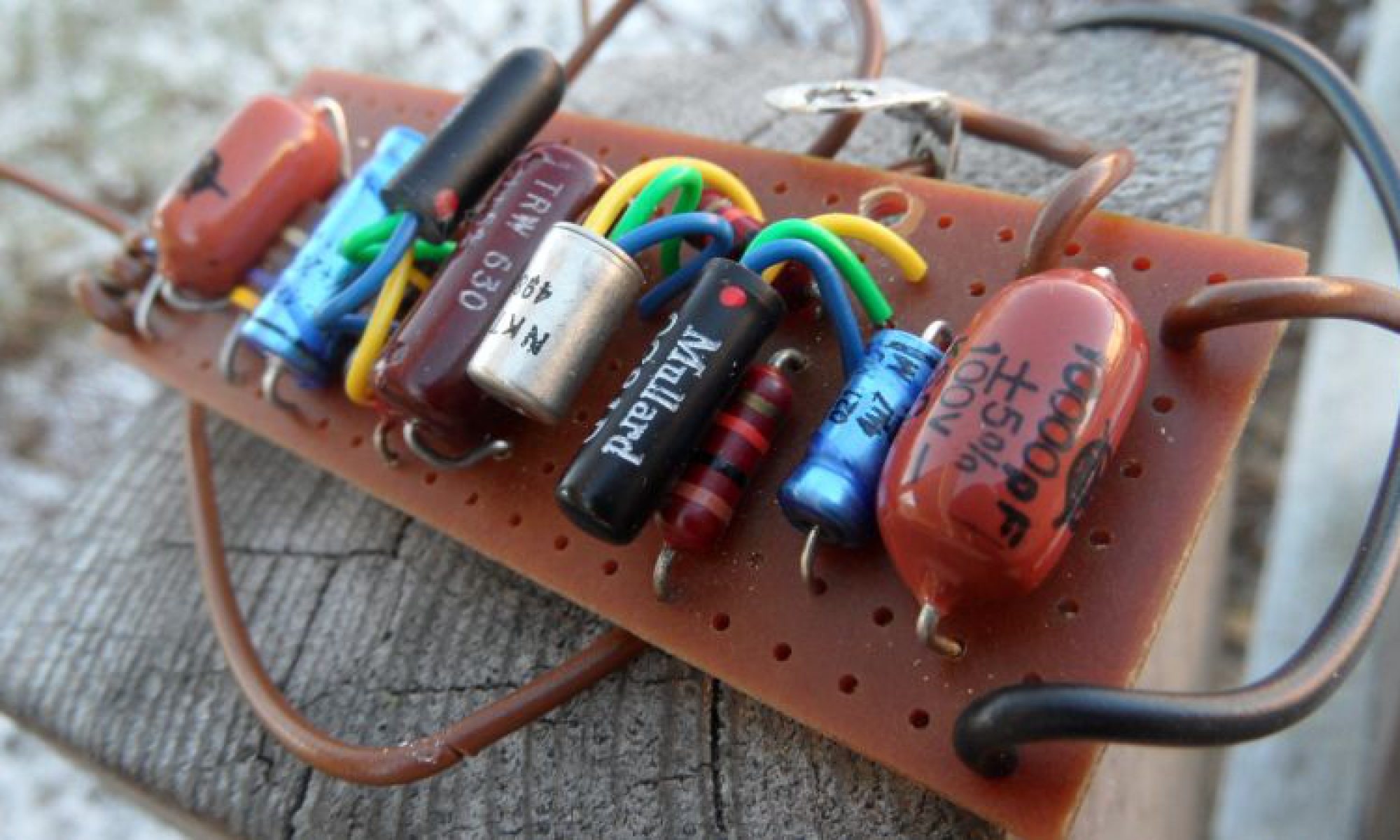
Boards and turrets! Yeah!

Here’s fun little project.
Easily can be squeezed into tinny A type enclosure.
Similar circuit topology could be found in JEN and Elka Treble-Bass Boosters
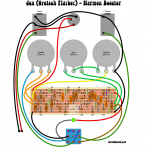 I don’t know what it is, I never build it before, quite recently I heard about it first time. It’s called Harmon Booster, but AFAIK it’s more like overdrive.
I don’t know what it is, I never build it before, quite recently I heard about it first time. It’s called Harmon Booster, but AFAIK it’s more like overdrive.
Guys on interwebz says it’s cross between Tube Screamer with Big Muff voicing. Cool description! It may be fun.
The real one was build on PNP silicon BC318C. I did my layout with offboard wiring for negative ground powering instead.
Up to you how you’ll wire it up.
Also LED limiting resistor was added on board, and 3PDT switch wiring is showed
Report back how you like it, I miss your emails 🙂
Big thumbs up and credits to SonicIV for schematic
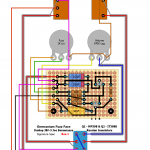
Another Dunlop Fuzz Face variant.
As my previous layout, this perfboard is based on Electric Warrior’s work with just few components added to match it to JBF-3 spec.
What’s the Fuzz is All About? Firstly, it has one more component to (AFAIK) prevent squealing at higher Fuzz settings.
Secondly, it’s PNP germanium circuit. Old stock Russian transistors ware used.
JBF-3 was short lived limited to 300 units only. It’s gone by now, so here’s your chance to build one.
I did another layout with external bipolar power supply, but I wasn’t sure connections, so I decide to let you see it as is – bare bone.
Get your PDF project file here
Enjoy
LAYOUT CONTAINS ERRORS – corrected version to view here http://turretboard.knucklehead.dk/?p=1642
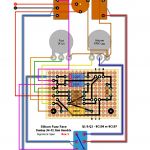
Last Dunlop Fuzz Face Hendrix reissue. This one was designed by Jeorge Tripps, well know man behind Way Huge effect. Few cool mods ware applied, mainly to stabilize and prevent RF pick-up.
Here’s the lil layout I did (PDF). I was inspired by Electric Warrior’s perfboard Fuzz Face layout, he done years ago.
I just simply added few components as per JH-F1 spec.
Still a lot of vintage charm and vibe.
Q2 collector bias in this model is set quite high, way higher than standard 4.5v.
I’m not sure about Q1 collector bias, it seems to be around 1.4v, so not far away from typical FF Q1 bias point.
In JH-F1 those bias points are preset at the factory with SMD trimmers on trace side under the board. Use a pot to set it, measure the bias with your DMM and pick-up closest value resistor from your stash, if you want to go anal, measure your resistors to pick up the exact one.
47pF capacitor isn’t confirmed. In JF-F1 it’s unmarked SMD type, should be between 47pF and 150pF.
Another out of production D*A*M custom project. Head Buzz is basically standard Fuzz Face – no mods.
Done for Japanese market only.
Total of four versions was issued AFAIK:
PNP germanium – all with holly NKT275’s and NPN silicon on BC108, and some on BC183L – similar to MK1.5 Bender appearance, but build on 0.1″ pitch stripboard with expanded space to accommodate 1/2W resistors and full sized axial capacitors. Basically standard Fuzz Face spec, but linear taper Volume pot and 6k8 Q2 bias resistor in silicon version. These two had no shielded wire off-board wiring.
Please note floating wire coming from DPDT switch – track it to under the switch, or find other grounding point to enclosure. Otherwise expect huge amount of squealing and RF pick up
The other two versions are all silicon. This time dead-on MK1.5 layout presence, made with 0.15″ pitch vero, and shielded wire off-board wiring was used this time.
– First one has also stock Fuzz Face specification, we see BC108, BC183L, or BC209 transistors here, depend on issue, linear taper Volume and 8k2 Q2 bias resistor, no changes after that
– The other one 0.15″ vero version is odd. It was build to ordered for D*A*M’s Japanese dealer to mimic “drift and sag” on one of their favorite vintage units. Electrolytic capacitors are mystery to me, I can’t see part values, but resistors are clearly visible. If I get more info, I’ll update this page ones again
————————————————————————
IMPORTANT UPDATE 13/06/2012
Due to D*A*M counterfeit pedals that recently appeared on the marked all D*A*M straight layouts will be removed from turretboard.org and will be replaced soon with our own works and interpretations.
————————————————————————
Here’s the good old VOX AC30/6 from Richard’s workshop. Richard as you may know helped me a lot drawing AC30 tagboard layout as well as he donated his hand drawn chassis plans of exactly this amp to my website. Now time for chassis pron 😉
You guys enjoy, thanks a lot Richard
Do you remember Richard? He helped me a lot with my VOX AC30 tagboard layout. He is still at it. He let me to publish on my website his chassis info, hand drawn plans to make your own chassis. JMI era chassis in not the same as the ones in current production VOX reissues, the ones sold by Weber VST is close, but still not exact. AFAIK Vintage Pedal Workshop stock those, and it’s noted on their site that faceplates and transformers comes next, but these plans gives you kind of independence. Richard says that he’s working on cab, so keep your eyes and come back often.
With this project you’ll be able to build almost every classic WahWah.
My layout was created for look and mojo, not the size. Everything is in line, looks nice and tidy 🙂
It takes 1/2 CC resistors and Tropical Caps nicely. For E-cap try BC Electronics 4u7 63-100v
Part names match the ones used by RG.Keen in Wah Article, I don’t think I could use RG’s schematic, so I draw mine – shown below
Schematic shows exemplar part values to build few of these famous classic wah pedals, I’m sure you can build much more projects than suggested, including other popular variants like Boomerang, Colorsound or Shinei wahs – just pick values from your favorite wah schematic, and match to schemo provided here.
‘Rpull’ is pulldown resistor on input to prevent popping, 2m2 is what I’m using usually
Have fun